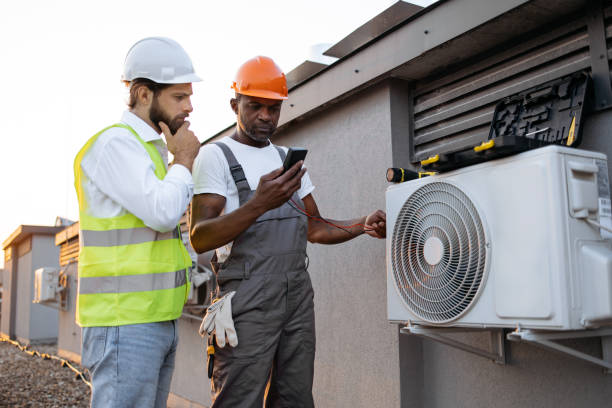Menu list
- Introduction to Smart HVAC Control
- Enhanced Convenience Through Mobile App Integration
- Voice Assistant Integration for Hands-Free Operation
- Energy Efficiency and Cost Savings
- Improved Indoor Air Quality and Comfort
- Seamless Integration with Smart Home Ecosystems
- User-Friendly Interfaces and Accessibility
- Conclusion
Introduction to Smart HVAC Control
Home comfort is undergoing a dramatic revolution thanks to the rise of smart HVAC systems, which are fundamentally altering how people experience indoor living. These innovative solutions are no longer just about heating or cooling; they now have advanced sensors that detect environmental changes, intelligent controls that learn your preferences, and seamless connectivity options that make remote management easy. This holistic approach doesn’t simply automate temperature settings – it empowers users with a more proactive role in maintaining a comfortable, healthy environment. What truly sets modern systems apart is the integration of mobile apps and voice assistants—capabilities that have rapidly gained popularity as homeowners increasingly seek customized control and seamless efficiency. If you’re exploring your options for centralized heating and cooling, advanced ducted heat pumps now pair ultra-high efficiency ratings with smart connectivity for the ultimate in modern home management.
Enhanced Convenience Through Mobile App Integration
Remote Control Capabilities
Mobile app integration empowers homeowners to adjust HVAC settings from virtually any location, expanding traditional functionality beyond the limitations of in-home control. Whether you’re arriving home from a long day at work, traveling on vacation, or simply lounging on the couch, a few taps on your smartphone lets you raise or lower the temperature, activate eco mode, change fan speeds, or toggle between heating and cooling. This means you never have to worry about coming home to an uncomfortable house or leaving the system running wastefully when the house is empty. Making adjustments on demand ensures energy efficiency and consistent, personalized comfort, regardless of where you are.
Scheduling and Automation
Smart HVAC mobile apps are loaded with programmable schedules and advanced automation features. You can easily set up daily and weekly routines to align with your unique lifestyle and occupancy patterns. For example, your system might lower the temperature before bed, raise it in the morning before you wake, and return to an energy-saving mode after you leave for work. Some apps even allow you to set up vacation schedules, ensuring your system only runs when needed. These individualized settings keep your living space optimized for comfort and prevent excessive energy consumption when the house is unoccupied.
Real-Time Notifications and System Alerts
Another powerful feature of many top-rated apps is real-time notifications for system status updates, periodic maintenance reminders, and important emergency alerts like unusual temperature swings or equipment malfunctions. For instance, if your filter is due for a change or the system detects abnormal humidity levels, you’ll get an instant alert, allowing you to act quickly and keep your system running reliably. This proactive communication minimizes costly downtime and ensures your HVAC operates at peak performance. Plus, access to detailed logs and alert histories lets you track long-term patterns and respond to issues before they become serious.
Voice Assistant Integration for Hands-Free Operation
Popular Voice Assistants
Modern HVAC systems increasingly support integration with popular voice assistants, which lets you issue simple voice commands to control various system functions. Whether you want to adjust the temperature, switch operating modes, ask for the current room climate, or check filter status, you can do it all hands-free. This means that even if your hands are occupied with cooking, cleaning, or carrying groceries, you still control your indoor comfort. Voice control provides a practical solution for busy individuals, those with mobility challenges, or anyone seeking a little more ease in their daily routines.
Unified Smart Home Experience
The greatest strength of voice integration lies in its ability to sync your HVAC system with the broader smart home ecosystem. Imagine telling Alexa, “Start bedtime routine,” and having your home respond by dimming the lights, locking the doors, closing the blinds, and fine-tuning the thermostat to your preferred nighttime temperature—all in perfect harmony. Through routines and custom scenes, voice assistants make a truly unified, intuitive living experience possible that goes far beyond the thermostat. Whether setting a cozy mood for movie night or ensuring efficiency when you leave for work, automation delivers consistent convenience.
Energy Efficiency and Cost Savings
Learning and Optimization
Today’s intelligent HVAC systems employ adaptive algorithms to analyze user preferences and optimize energy use over time. These systems monitor temperature adjustments, occupancy patterns, and external weather conditions to anticipate needs and reduce unnecessary heating or cooling. Over time, your system “learns” the most efficient ways to run, taking guesswork out of comfort management. This technological advancement enhances your experience and supports broader energy conservation goals.
Lower Utility Bills
Efficient energy management is a direct pathway to lower utility bills. By ensuring that your heating or cooling system runs only when needed and at optimal settings, smart controls eliminate energy waste often accompanying traditional HVAC usage. The result is real savings: many homeowners report notable reductions in their monthly energy costs after upgrading to smart thermostats and integrated HVAC controls, making the initial investment financially worthwhile in the long run.
In-Depth Analytics
Advanced mobile apps provide detailed insights into your home’s energy consumption patterns. Usage breakdowns, historical trends, and real-time analytics make it easy to spot inefficiencies, adjust habits, and maximize savings. These transparent reports empower you to make informed temperature settings, scheduling, and maintenance decisions.
Improved Indoor Air Quality and Comfort
Monitoring and Adjusting Air Quality
Modern smart HVAC systems are designed for more than just temperature management—they incorporate sophisticated air quality monitors and humidity controls and can even integrate with advanced air purification or ventilation units. Through the app, you can track indoor air quality, regulate humidity for physical well-being, and receive alerts when it’s time to replace filters or service the system. These features provide a cleaner, healthier indoor environment and promote longer equipment life.
Zone-Based Customization
Smart HVAC configurations often allow for zone-based climate control, letting you tailor comfort settings in specific rooms or sections of your home. For example, maintain a cool bedroom for sleep, while keeping the living room warmer for guests. Personalized comfort is further enhanced with customizable presets and easy adjustments on the fly—perfect for homes with varied usage patterns or multiple family members with different preferences.
Seamless Integration with Smart Home Ecosystems
Cross-Device Compatibility
The best HVAC systems are engineered for compatibility with a wide range of other smart home devices, including lighting, security, and entertainment systems. This allows for fully integrated scenarios where your indoor climate, lighting ambiance, and even your favorite playlists can work in sync. By linking your HVAC to other smart controls, you simplify daily management to a single app or voice platform.
Automated Scenarios and Routines
Through either the mobile app or your voice assistant, you can create and activate custom routines or scenarios with just one command. For example, you can set up a “good morning” routine that brightens lights, adjusts the thermostat, and starts your coffee maker all at once or an “away” mode that locks the doors, switches off lights, and conserves HVAC energy. Integrated automation means higher efficiency and less manual effort required each day.
User-Friendly Interfaces and Accessibility
Intuitive Designs
Smart HVAC apps are thoughtfully crafted with user experience as a top priority. Their clean, intuitive interfaces make navigation effortless, and all essential controls are accessible within a tap or swipe. From first-time users to seasoned pros, the design ensures anyone can set up and operate the system without frustration.
Accessibility for All
Leading mobile apps go the extra mile to ensure inclusivity, incorporating screen reader compatibility, customizable font sizes, and voice-guided navigation for those with visual or physical impairments. This level of accessibility ensures everyone can benefit from advanced comfort, regardless of individual needs or abilities.
Continuous Updates and Support
Manufacturers are continually improving their HVAC software through regular updates, providing new features, essential security enhancements, and increased interoperability with other devices. Direct access to documentation, FAQs, and customer support from within the app provides vital reassurance and makes troubleshooting or learning about new features a breeze.
Conclusion
Integrating mobile apps and voice assistants into your HVAC system redefines comfort, efficiency, and home control standards. From hands-free commands and smart scheduling to advanced system monitoring and integration with other devices, these technologies firmly place comprehensive indoor environment management in your hands. As the trend toward connected living grows, investing in a smart HVAC solution is a practical step toward a more comfortable, efficient, and future-ready home.





